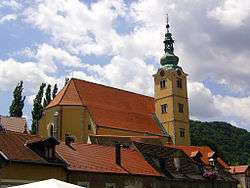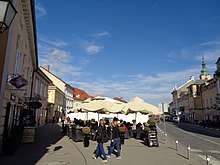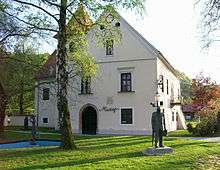Samobor
Samobor (pronounced [sâmɔ̝bɔ̝ːr]) is a city in Zagreb County, Croatia. It is part of the Zagreb metropolitan area.
Samobor | |
|---|---|
| Grad Samobor City of Samobor | |
     Top: Church of Saint Anastasia; Center left: Samobor Fountain; Center right: Main Square; Bottom left: Gradna; Bottom right: Samobor mustard sign | |
 Samobor Location of Samobor within Croatia | |
| Coordinates: 45°48′N 15°43′E | |
| Country | |
| County | |
| Free royal city | 1242 |
| Settlements | 77 settlements |
| Government | |
| • Type | Mayor-council |
| • Mayor | Krešo Beljak (HSS) |
| • City Council | 25 members
|
| • Electoral district | 7th |
| Area | |
| • City | 250.73 km2 (96.81 sq mi) |
| Highest elevation | 860 m (2,820 ft) |
| Lowest elevation | 127 m (417 ft) |
| Population (2011)[1] | |
| • City | 37,633 |
| • Density | 150/km2 (390/sq mi) |
| • Urban | 18,659 |
| Time zone | UTC+1 (CET) |
| • Summer (DST) | UTC+2 (CEST) |
| Postal code | HR-10 430 |
| Area code | +385 1 |
| Vehicle registration | ZG |
| Patron saints | St. Anne |
| Website | http://www.samobor.hr |
Geography
Samobor is located west of Zagreb, between the eastern slopes of the Samobor hills (Croatian: Samoborsko gorje), the eastern part of Žumberak Mountains, in the Sava River valley. It is part of the historical region of Croatia proper.
Administration
The city government, court, police, health service, and a post office are part of the Samobor infrastructure.
History
Samobor has existed as a free royal town[2] since 1242, according to a document of endowment by King Béla IV.
Since the Treaty of Karlowitz in 1699, Szamobor was part of the Habsburg Monarchy, (Transleithania after the compromise of 1867), and soon after in the Kingdom of Croatia-Slavonia, created when the Kingdom of Slavonia and the Kingdom of Croatia were merged in 1868. In the late 19th and early 20th century, Samobor was a district capital in the Zagreb County of the Kingdom of Croatia-Slavonia.
Economy
One of the chief industries in Samobor is crystal cutting, acclaimed in Europe and all over the world.
Notable natives
Many well-known people were born or lived in Samobor. Such notable personalities are:
- Tvrtko Kale (born 1974), Croatian-Israeli footballer
- Ferdo Livadić, a prominent member of the nationalist Illyrian movement in the 19th century, piano composer and writer of the most famous Croatian patriotic song (Croatian: budnica) of the 19th century, Još Hrvatska ni propala (English: Croatia Hasn't Perished Yet)
- Antun Gustav Matoš, poet and writer, lived in Samobor for four years
- Antonio Šančić, tennis player
Population
| Year | Pop. | ±% |
|---|---|---|
| 1880 | 16,548 | — |
| 1890 | 18,607 | +12.4% |
| 1900 | 18,783 | +0.9% |
| 1910 | 20,275 | +7.9% |
| 1921 | 19,806 | −2.3% |
| 1931 | 21,953 | +10.8% |
| 1948 | 23,821 | +8.5% |
| 1953 | 25,451 | +6.8% |
| 1961 | 27,103 | +6.5% |
| 1971 | 28,469 | +5.0% |
| 1981 | 32,887 | +15.5% |
| 1991 | 35,017 | +6.5% |
| 2001 | 36,206 | +3.4% |
| 2011 | 37,633 | +3.9% |
| Source: Naselja i stanovništvo Republike Hrvatske 1857–2001, DZS, Zagreb, 2005 | ||
In the 2011 Croatian census, the total population of the administrative territory of Samobor was 37,633, distributed in the following settlements:[1]
Settlements
- Beder, population 83
- Bobovica, population 282
- Braslovje, population 343
- Bratelji, population 17
- Bregana, population 2,444
- Breganica, population 65
- Brezovac Žumberački, population 26
- Budinjak, population 9
- Bukovje Podvrško, population 31
- Celine Samoborske, population 292
- Cerje Samoborsko, population 377
- Cerovica, population 6
- Dane, population 14
- Dolec Podokićki, population 83
- Domaslovec, population 939
- Draganje Selo, population 83
- Dragonoš, population 23
- Drežnik Podokićki, population 245
- Dubrava Samoborska, population 243
- Falašćak, population 136
- Farkaševec Samoborski, population 455
- Galgovo, population 685
- Golubići, population 17
- Gornja Vas, population 32
- Gradna, population 523
- Grdanjci, population 308
- Gregurić Breg, population 115
- Hrastina Samoborska, population 833
- Jarušje, population 72
- Javorek, population 74
- Kladje, population 810
- Klake, population 237
- Klokočevec Samoborski, population 366
- Konšćica, population 285
- Kostanjevec Podvrški, population 89
- Kotari, population 59
- Kravljak, population 15
- Lug Samoborski, population 973
- Mala Jazbina, population 479
- Mala Rakovica, population 748
- Mali Lipovec, population 123
- Manja Vas, population 79
- Medsave, population 242
- Molvice, population 640
- Noršić Selo, population 134
- Novo Selo Žumberačko, population 24
- Osredek Žumberački, population 17
- Osunja, population 13
- Otruševec, population 300
- Pavučnjak, population 566
- Petkov Breg, population 279
- Podgrađe Podokićko, population 164
- Podvrh, population 561
- Poklek, population 34
- Prekrižje Plešivičko, population 14
- Rakov Potok, population 1,131
- Rude, population 1,127
- Samobor, population 18,659
- Samoborski Otok, population 597
- Savršćak, population 199
- Selce Žumberačko, population 4
- Sječevac, population 14
- Slani Dol, population 208
- Slapnica, population 16
- Slavagora, population 74
- Smerovišće, population 116
- Stojdraga, population 51
- Sveti Martin pod Okićem, population 259
- Šimraki, population 7
- Šipački Breg, population 44
- Tisovac Žumberački, population 2
- Velika Jazbina, population 259
- Velika Rakovica, population 504
- Veliki Lipovec, population 85
- Višnjevec Podvrški, population 42
- Vratnik Samoborski, population 108
- Vrbovec Samoborski, population 271
- Vrhovčak, population 345
Monuments and sightseeings

.jpg)

Samobor is one of the earliest tourist resorts in the region, with the first tourist facilities dating back to 1810, catering to anglers, hunters and hikers. The town's beautiful surroundings and vicinity to the capital have supported this tourist tradition to the present day. In 1846, Samobor was paid a visit by the composer Franz Liszt, who at that time was visiting Zagreb during one of his numerous concert tours. Liszt came to Samobor to see his friend Ferdo Livadić, in his lodgings at the Livadić mansion, which is today the town museum. At the beginning of the 20th century, the Livadić mansion came under the ownership of a Jewish family named Daničić. They were forced to leave as a result of the Nazi invasion in 1941. Shortly after this, the mansion was confiscated by the newly formed Independent State of Croatia and never returned to the Daničić family.
- On Tepec hill, only 10 minutes walk from the city centre, there are still-visible remains of the Samobor Castle fortress built in the 13th century.
Education
There are two elementary schools and one high school in Samobor:
- Osnovna škola Bogumil Toni (English: Bogumil Toni Elementary School)
- Osnovna škola Samobor (English: Samobor Elementary School)(formerly Osnovna škola Janko Mišić)
- Srednja škola Samobor (English: Samobor High School), consisting of two academies teaching arts such as economy and trade; the Gimnazija Antuna Gustava Matoša (English: Antun Gustav Matoš Comprehensive School);
and the Srednja strukovna škola Samobor – with technical studies, hairdressing, etc.
There is also a music academy – Glazbena škola Ferdo Livadić.
Sport
The local football club is NK Samobor, who play in the Treća HNL. The local woman's handball club is ŽRK Samobor, who play in the Prva HRL. The local men's handball clubs are RK MladosT 09, and RK Rudar, who play in the Premijer liga. The local basketball club is KK Samobor, who play in the Druga muška liga, reija Centar. The local judo club is Judo Klub Samobor. The local karate club is Karate klub Samobor.
International relations
Twin towns — Sister cities
Samobor is twinned with:
See also
References
- "Census of Population, Households and Dwellings 2011" (HTML). Census of Population, Households and Dwellings 2011. Zagreb: Croatian Bureau of Statistics. December 2012. Retrieved 5 July 2013.
- Treasures of Yugoslavia states "granted free trading rights before 1242".
External links
| Wikimedia Commons has media related to Samobor. |

